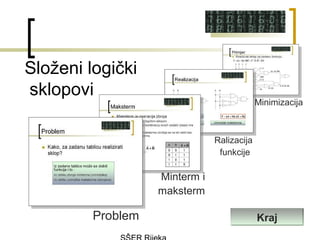slo?eni logi?ki sklopovi
- 1. Slo?eni logi?ki sklopovi Minimizacija Ralizacija funkcije Minterm i maksterm Problem Kraj
- 2. Problem ? Kako za zadanu tablicu realizirati sklop? Iz zadane tablice mo?e se dobiti funkcija i to : ?U obliku zbroja minterma (umno?aka) ?U obliku umno?ka maksterma (zbrojeva).
- 3. Realizacija minterma i maksterma ? Minterm je operacija umno?ka ? Realizira se logi?kim I sklopom ? Za samo jednu kombinaciju vrijednosti varijabli (ulaza) ima vrijednost 1 ? Broj razli?itih minterma ovisi o broju varijabli (ulaza) i iznosi 2n, n ©C broj varijabli (ulaza) AB A B AB 0 0 0 0 1 1 Realiziraj preostale 1 0 0 minterme s 2 ulaza 1 1 0
- 4. Maksterm ? Maksterm je operacija zbroja ? Realizira se ILI logi?kim sklopom ? Za samo jednu kombinaciju svojih varijabli (ulaza) ima vrijednost 0 ? Broj razli?itih maksterma utvr?uje se na isti na?in kao u slu?aju minterma A+B A B A+B 0 0 1 0 1 1 Realiziraj preostale 1 0 1 maksterme s 2 ulaza 1 1 0
- 5. Realizacija sklopova zbrojem minterma i umo?kom maksterma ? Od kombinacija varijabli za koje funkcija ima vrijednost 1 dobije se zbroj minterma ? Minterm mora imati vrijednost 1 kada se u njega uvrsti odgovaraju?a kombinacija vrijednosti varijabli ? Od kombinacija za koje funkcija ima vrijednost 0 dobije se umno?ak maksterma ? Maksterm mora imati vrijednost 0 kada se u njega uvrsti odgovaraju?a kombinacija vrijednosti varijabli
- 6. Primjer EX ILI funkcija A B Y 0 0 0 A+ B Za A = B = 0 maksterm ima vrijednost 0 0 1 1 AB Za A = 0 i B = 1 minterm ima vrijednost 1 1 0 1 AB Za A = 1 i B = 0 minterm ima vrijednost 1 1 1 0 A+B Za A = B = 1 Maksterm ima vrijednost 0 Y = ( A + B) ? ( A + B) Y = AB + A B
- 7. Realizacija Y = AB + A B Y = ( A + B) ? ( A + B) Zbroj minterma Umno?ak maksterma
- 8. EX ILI funkcija ? Rije? je o dva razli?ita oblika iste funkcije. Y = ( A + B) ? ( A + B) = = A A + A B + AB + BB =; A A = 0, BB = 0 = A B + AB
- 9. Logi?ki sklop isklju?ivo ILI ? Isklju?ivo (EX) ILI funkcija mo?e se realizirati zbrojem minterma i umno?kom maksterma ? Me?utim, postoji logi?ki sklop za tu funkciju A B Y 0 0 0 0 1 1 1 0 1 Y = A©ÆB 1 1 0 Na izlazu ima vrijednost 1 ako je, isklju?ivo na jednom od ulaza vrijednost 1.
- 10. Isklju?ivo (EX) NILI A B Y 0 0 1 0 1 0 1 0 0 Y = A©ÆB 1 1 1 Funkcija: Y = A B + AB Y = ( A + B)( A + B)
- 11. Minimizacija ? Zakoni Booleove algebre primjenjuju se prilikom minimizacije funkcije ©C algebarska metoda ? Minimizacija je postupak transformacije funkcije tako da bude realizirana s najmanjim mogu?im brojem logi?kih sklopova ? Algebarska metoda nije pouzdan na?in minimizacije funkcija ? Postoje metode, poput primjene Karnaugh ©C ovih tablica pomo?u kojih se funkcija pouzdano minimizira
- 12. Primjer ? Realizirati sklop za zadanu funkciju: Y = ( A + D) ? ABC + C + D ? B + AD
- 13. Minimizacija funkcije Y = ( A + D) ? ABC + C + D ? B + AD Dvostruki komplement = ( A + D)ABC + C ? D ? BAD De Morganovo pravilo = ( A + D)ABC + CDB( A + D) De Morganovo pravilo = A ABC + ABCD + ABCD + BCDD =0 = ABC( D + D) + BCD =1 = ABC + BCD Nacrtaj sklop
- 14. Pokus ? Program Logisim omogu?ava minimizaciju (Pokus 3) upisane funkcije ili nacrtanog sklopa ? Odabirom naredbe Analyze Circuit u izborniku Project te kartice Minimized mo?e se vidjeti kako bi se izvela minimizacija putem Karnaug ©C ovih tablica ? Klikom na gumbe Set As Expression i Build Circuit izvodi se minimizacija
























![Digeldl zbirka z_cjelina12[2]](https://cdn.slidesharecdn.com/ss_thumbnails/digeldlzbirkazcjelina122-150407101238-conversion-gate01-thumbnail.jpg?width=560&fit=bounds)

















